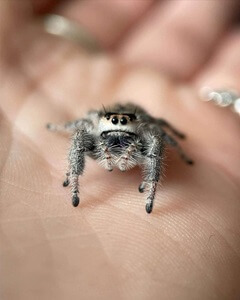How Much do Jumping Spiders Cost?
Last Updated on December 8, 2023
Written by CPA Alec Pow | Content Reviewed by ![]() CFA Alexander Popinker
CFA Alexander Popinker
Forget fur and feathers – the internet’s new darlings have eight legs and can leap vast distances relative to their tiny sizes. We’re talking about jumping spiders! Videos of these photogenic arachnids with fake voices have won millions of hearts.
If you’re wondering what’s involved in keeping adorable jumpers, this guide covers ideal types, proper care, costs, lifespan, and more. With basic needs met, these mini acrobats make lively, low-fuss friends. Let’s go over the cost of a jumping spider.
How Much do Jumping Spiders Cost?
When sourced from reputable breeders, jumper spiders usually cost anywhere between $20 and $50 for a juvenile spiderling, $50 to $100 for an adult female, or $20 to $50 for an adult male.
Males often cost less due to shorter 1-year lifespans. Rarer coloring morphs also fetch higher prices.
So plan around $20-$100 to get your first jumper ambassador, probably a young juvenile. Now let’s tally supplies…
Thanks to small sizes and minimal provisions, jumping spiders are one of the most economical exotic pets. Upfront costs include:
- Spider – $20-$100 depending on age and species rarity.
- Enclosure – $10-$30 simple plastic box setup.
- Supplies – Around $5 per month for food items and substrate.
Some breeders sell complete habitats too. So under $100 in total should get you started. Compared to the recurring expense of furry or feathered friends, these pocket-sized acrobats stay very budget-friendly.
A Reddit user, for example, shared their experience buying jumping spiders, mentioning that they paid $10 for one and $15 for another, with shipping costing around $20 per shipment.
The Spiders Source website offers a variety of jumping spiders for sale, including Regal Jumping Spiders in different color variations. The prices range from $45 to $75 for individual spiders.
A-Z Animals provides information about different types of jumping spiders available as pets, including the Regal Jumping Spider and the Bold Jumping Spider. The cost of these spiders is listed as ranging from $20 to $75.
Itsy Bitsy Friends is another website that offers jumping spiders like Phidippus Regius Regal for around $40, Phidippus Audax Bold Jumping Spiders for $35, and Hybrid Regal/Otiosus Jumping Spiders for $45.
The Bugg Plug website offers captive-bred Phidippus species, including Regal Jumping Spiders, for sale, with roughly similar prices.
Pet Jumping Spider Habitat Costs
As tiny tenants, pet jumping spiders need only modest enclosures using:
- Enclosure – $10-$30 for a plastic critter keeper, jar, or display case
- Substrate – $5 bag of coconut fiber, paper towel or chemical-free soil
- Decor – $3-$10 for mini artificial plants, hides and webbing
- Water Dish – Reuse a bottlecap
So about $20 should be enough to furnish their habitat nicely. This is marginally higher if opting for very decorative setups.
Feeding a Jumping Spider: Food Costs
While spiders have big appetites for their small size, feeder insects stay economical when purchased in bulk:
- Pinhead Crickets – $8 per 1,000 ct container
- Flightless Fruit Flies – $12 per 1,000 ct culture cup
- Roaches, Waxworms, etc. – Vary in pricing
One cup of size-appropriate feeders lasts many weeks in a mini fridge. So estimate ~$10 monthly for spider food costs.
Vet Care, Misting Supplies, and More
Beyond fundamental habitat components and feeders, also budget for:
- Exotic pet vet fund – $100+ yearly
- Misting bottle – $5 initial purchase
- Escape proofing – $5 mesh wire, tape, etc.
- Care guides – $15 spider keeper books
Now for vital caretaking do’s and don’ts…
Husbandry Tips for Healthy, Happy Spiders
While tiny, spiders have complex physiologies keeping ideal homes essential. Follow these tips:
- Research fully before acquiring jumpers
- Allow handling reluctance
- Keep enclosures clean, humid, and roomy
- Speak softly and move gently around them
- Provide hiding spots and high perches
- No handling after applying lotions or perfumes
- No housing with other species
Giving your pint-sized buddies proper provisions keeps enjoyment high and lifespans to the max.
Tiny Web Stars: What Fuels Jumping Spider Fame?
 While spiders often have icky reputations, something about enthusiastic little jumpers warms spirits. Maybe it’s seeing them wave pedipalps like furry boxing gloves. Or their head-tilting gazes when spoken to. Whatever the charm, short social clips propelled jumpers to unlikely stardom.
While spiders often have icky reputations, something about enthusiastic little jumpers warms spirits. Maybe it’s seeing them wave pedipalps like furry boxing gloves. Or their head-tilting gazes when spoken to. Whatever the charm, short social clips propelled jumpers to unlikely stardom.
You might also like our articles about the cost of a tarantula, praying mantis, or antivenom.
Jumping spiders make amazing pets – friendly, docile, curious, and able to bond with owners. That’s why people call them ‘web puppies’! Meeting one shows how special they are.
So what’s their care like? It’s actually very easy – small enclosures, occasional misting, and 2-3 feedings per week. Their needs are minimal.
Now let’s see the top species highlights and trait basics…
Most Suitable Jumping Spider Varieties for Pets
While all 200+ jumping spider species share agility and smarts, several types tend to be better as companions. Here are the best picks:
Regal Jumping Spider
One of the largest jumpers at 6-22mm long, regals charm with fluffy pedipalps and color-shifting coats. Despite their size, they become quite trusting and enjoy out-of-enclosure adventures.
Bold Jumping Spider
At 8-18mm, bold jumpers look like regals but with defined black-and-white adult coloring. They act more timid initially but warm up and love to zip around.
Canopy Jumping Spider
Very similar to regals in 8-18mm frames, canopy jumpers set themselves apart with wildly hued chelicerae (mouth appendages) in greens, blues, and purples. Their leg bands also differ.
Plus over a dozen other species that breeders regularly keep. Now for universal care insights…
Habitat and Handling Needs
While color patterns distinguish jumper types, their daily provisions share similarities:
- Enclosure – Plastic boxes 4-8 inches per side suit most adults. Supples hides and plants.
- Hydration – Mist one wall daily as they drink condensed droplets.
- Feeding – 2-3 times weekly with pinhead crickets, flies, and other appropriately sized feeders.
- Temperature – Keep ambient enclosure air 70-80°F.
- Light – Provide daylight simulation and darkness periods.
With basic habitat needs met, jumpers thrive for 1-3 years typically.
Frequently Asked Questions
For the squeamish, spider traits might seem unsettling at first. But devoted breeders will go over misconceptions:
Aren’t they super fast and jumpy?
Tiny legs allow giant leaps to catch prey. But jumpers usually move cautiously around trusted handlers.
Will they escape enclosures easily?
Modern plastic habitats seal securely unlike old jar lids. Jumping is aimed upwards too, not sidling out slim container cracks.
Don’t they have short life spans?
Around 2 years on average, longer possibly. Dwarf hamsters average under 2 years too, so lifespans compare reasonably.
Now feels like the perfect time to make your first little web buddy leap home!
Final Words
Between the spider itself, housing, food, and vet savings – expect around $150-$250 in first-year costs, then ~$150 ongoing annually.
That makes these tiny daredevils incredibly economical companions! Their pint-sized provisions also mean you can sprinkle multiple fuzzily fabulous friends around your home with minimal added costs.


Leave a Reply
Want to join the discussion?Feel free to contribute!